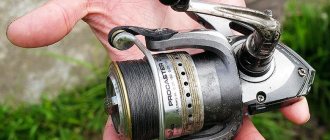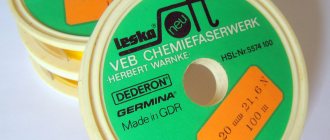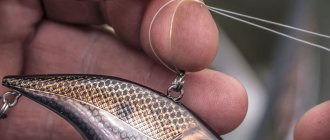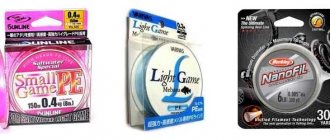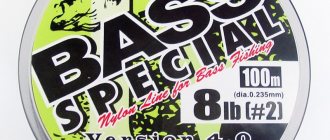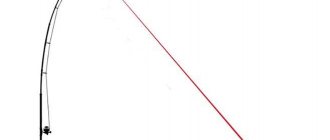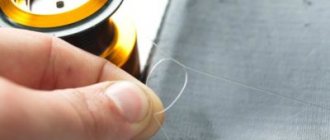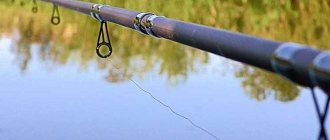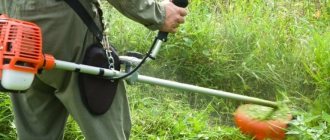The problem is also related to the fact that there is such a variety of fishing lines on the fishing equipment market that it is unlikely that you will be able to settle on any choice in one approach. Moreover, they all differ from each other in several parameters, such as color, thickness, tensile strength and material of manufacture.
Naturally, it will not be possible to choose a fishing line for all occasions, but you can come to the optimal solution.
Line color
The color of the fishing line does not particularly affect the performance, although in some cases it is necessary to pay very close attention to such a nuance.
What to pay attention to:
- When fishing in clear water, you should opt for a neutral, gray or marsh shade.
- If the river has a sandy bottom, then it is better to take a transparent or sandy-colored fishing line.
- If the pond has a muddy bottom or is dominated by vegetation, green or brown fishing line should be used.
- The yellow fishing line will be visible in any body of water.
- Dark colors make it difficult to control the wiring as it is not easy to see.
- Luminescent line allows for better control of the wiring. White or pink fishing line can be easily distinguished.
Thickness or diameter of spinning line
The effectiveness of spinning fishing depends on the diameter of the fishing line, if it is correctly selected for the fishing conditions. For catching small specimens, a fishing line with a diameter of 0.2-0.25 mm is sufficient. If the reservoir is clean and there is sand at the bottom, then the thickness of the fishing line can be reduced. For ultralight rods, a fishing line with a thickness of 0.12-0.14 mm is sufficient.
The thickness of the fishing line is also selected according to the weight of the baits: 25 g - 0.27 mm, 37 g - 0.35 mm and 45 g - 0.4 mm.
When choosing a fishing line, you should also take into account the test of the rod: test 1.5-12 g - line diameter 0.12-0.16 mm, test 7-30 g - line thickness 0.25-0.3 mm.
In addition to the thickness of the fishing line, there are several other factors that are also worth paying attention to. Before purchasing a product, you need to get as much information as possible about it.
Line used in spinning fishing // ABC of spinning fishing. Season 1.
The best fishing line for pike
Pike has very sharp teeth, with which it can easily bite through fishing line of any diameter and thickness. In addition, the fish strongly resists when fished, which requires suitable equipment. It is important that the fishing line for pike spinning is of small diameter, but with good tensile strength. Manufacturers produce special lines for pike fishing; you can recognize this line by the abbreviation PIKE on the packaging.
Experienced fishermen most often use braided line for spinning for pike. Such a cord is sensitive during animation, has a relatively small diameter, but has a high breaking load. Due to its elasticity and low memory, it becomes possible to cast light baits over long distances.
Monofilament is also used for “hunting” pike, but this type of fishing line is highly stretchable, which sometimes creates inconvenience when landing fish. In addition, nylon is less durable compared to other types of cord materials. Fluorocarbon fishing lines are most often used as a leader material; a cord with a diameter of 0.4-0.5 does not lend itself well to the teeth of a predator.
Monofilament line
Monofilament fishing line (monofilament) is widely popular among fishermen, as it can be used to catch any type of fish. The main material for its manufacture is nylon.
When choosing, you should pay attention to:
- For breaking load. It is indicated in kilograms and is directly dependent on the diameter of the fishing line. For example, a fish weighing 1 kg can be pulled out using a monofilament line 0.12 mm thick.
- Quality. Thanks to its integrity and smoothness, the fishing line lasts a long time. Inconsistent line thickness along the entire length leads to unpredictable breaks.
- To the actual diameter. You can find manufacturers who do not accurately indicate the diameter of the product, unreasonably overestimating or underestimating it.
- For color. It is better to equip the tackle with transparent fishing line. But this does not mean that other colors may be worse: it all depends on the fishing conditions.
Advantages of monofilament fishing line:
- Does not create much resistance when placing baits.
- It is not afraid of low temperatures and does not change its structure upon contact with water and frost. The only thing is that it becomes less flexible.
- It has a certain rigidity and is suitable for making leashes.
- It has a certain stretchability, which allows you to dampen the jerks of the fish, which cannot be said about the braided line. Perfect for mastering the principles of spinning fishing.
- It is characterized by a certain invisibility in water for fish.
- Excellent resistance to various underwater surprises, such as stones, driftwood or shell rock.
- It has excellent glide, which prevents the rings from wearing out quickly.
- Monofilament fishing line has more affordable prices.
Disadvantage of monofilament line:
- If you use thin monofilament lines with a low breaking load, they will quickly break.
- If you use it in direct sunlight for a long time, it may lose some of its properties.
- Increased specific stretch has not only a positive, but also a negative effect: it poorly transfers bites to the tip of the rod. In other words, the tackle turns out to be not so sensitive.
- Has memory. The fishing line can fix its position: when it is not on the spool, it leaves it in rings, which is not always convenient during fishing.
How to choose monofilament fishing line for spinning
Types of fishing lines for spinning
monofilament
Regular, solid nylon fishing line, suitable for catching any fish, is called monofilament or simply monofilament. When purchasing it, you should pay attention to the following indicators:
- Breaking load. It is expressed in kilograms and calculated based on the thickness of the thread. For example, a catch weighing one kilogram can be supported by monofilament with a diameter of just over one tenth of a millimeter.
- Thread strength. The integrity and smoothness of the fishing line ensures its high wear resistance. Manufacturers use monofilament coated with a special substance that improves glide and strength.
- True to actual size. Some manufacturers may lie when they indicate information about the thickness of the thread on the packaging.
In terms of color choice, it is better to choose a transparent fishing cord. As an experiment, you can purchase colored fishing line for spinning. The advantages of monofilament include the lack of resistance to water, resistance to low temperatures, the required rigidity of the thread, high elasticity, invisibility to fish, wear resistance and low price.
We also note the disadvantages: with a small diameter, it has a small breaking load, which is why the fishing line is subject to deformation, fragility (ultraviolet radiation worsens its properties), due to its ductility, the thread “remembers” its position and, when stretched from the reel, unwinds in wavy lines. And finally, it can be noted that, due to its stretchability, monofilament does not react well to a weak bite, and once you catch a fish on a hook, you have to “pull” it for quite a long time in order to pull it ashore.
Network
The second type of fishing line for spinning is braided. This is the name for a fishing line consisting of small synthetic threads tightly woven together, which are impregnated with special lubricants. Compared to monofilament, it is twice as strong.
Most often, it is braid that can be seen on modern spinning tackle. What are her positive qualities? This is high strength, non-extensibility, and therefore high sensitivity. Nowadays, braids are divided into the first and second generations. The first generation looks like a thread, the fibers in it are easily recognized. The second generation has a braid. At first glance, the second generation cord looks like monofilament.
The braid can be of very different colors, as well as multicolor (thread in strips of different colors). When required, you can use a cord to match the color of the bottom or water. Multicolor is perfect for cases when you need to actively monitor the movement of the fishing line.
Advantages of braid: no matter how the fisherman twists or wraps this thread, in any case the fishing line will maintain a straight and even shape, unlike the previous type (although some models are not so ideal), high strength, variety in the choice of colors, due to the lack of stretchability responds well to bite. Also, some manufacturers impregnate the braid with a special aromatic substance that attracts fish.
Speaking of disadvantages, it is worth mentioning the high sensitivity to cold temperatures (minus four degrees is a dangerous indicator), the inextensibility of the fishing line, due to which, if a large fish hits the hook, the thread can break, and the thread also absorbs water, losing functionality. And it's not cheap!
Fluorocarbon line
Let's consider another type of fishing line for spinning - fluorocarbon. It is based on chemical polymers. Used as a leash material. The composition of the thread ensures wear resistance and virtually invulnerability, but is expensive and often deformed, perfect for leashes about two meters long.
The main feature of fluorocarbon thread is that it is not visible in water due to the refractive index of light rays, which coincides with the refraction of water. Fish do not notice such fishing line at all.
Advantages: invisibility, resistance to wear, even the teeth of large predators cannot harm it, does not get tangled, sinks quickly, which is convenient on windy days, stretches slightly.
Disadvantages: due to its rigidity, it is difficult to tie the fishing line into a reliable knot, certain knots are required to secure the fluorocarbon thread, low breaking load, so it is not used as the main fishing line.
Braided cord, or as it is popularly called “braid,” has fairly good characteristics. Braid does not have a memory effect, such lines have almost no stretch, and they are also very durable.
Braided fishing line
It is called "braid" or "cord". With its advent, anglers had the opportunity to choose a fishing line, depending on the nature of fishing. Braid consists of several thinner synthetic threads woven together, which have a special impregnation and sheath (sometimes). If we compare it with monofilament fishing line, it has twice the strength.
Advantages of braid:
- She has no "memory". No matter what you do with this fishing line and no matter how long it is in this state, it will always return to its original state. Although there are developments where this principle does not work so strongly.
- High strength. Despite this, it loses its characteristics with frequent contacts with underwater surprises.
- A large number of flowers. It is possible to select this element of gear for various fishing conditions. If you choose contrasting shades, you can always control the process of placing the bait.
- High sensitivity. Thanks to the low specific stretch coefficient, it instantly transfers bites to the tip of the spinning rod.
- Doesn't stretch. This property allows you to “rescue” baits that are caught on various obstacles. The hook will straighten faster than the line will break.
- Presence of impregnation. Such fishing lines are impregnated with compounds that improve its technical performance, as well as with flavors that help attract fish.
The disadvantages of braiding include:
- Its not stretchable. When catching a large specimen, the entire load is applied to the rod, which can lead to its breakage. In other words, braided line does not soften the jerk of the fish.
- Its visibility in the water. As a rule, there is no transparent braid. Any color can alert the fish.
- She is afraid of low temperatures. Temperatures of -4°C are already affecting its performance. At low temperatures, wet fishing line becomes enveloped in frost and its elasticity is lost. Several similar conditions for it, and it may be unsuitable for further use.
- Capable of absorbing moisture. This is a very bad property, which leads to the loss of its functionality, since it cannot always be dried.
- Its cost. It costs more than monofilament fishing line, but may last less.
Fluorocarbon line
Its production is based on chemical polymers. Few people use it as a main fishing line, despite the fact that it is wear-resistant. Unfortunately, it is not as strong as monofilament and braided fishing line, and besides, its price does not allow it to be used as a main fishing line, since there are other, cheaper options. Due to the fact that it is not visible in the water, it is widely used as a leader material. Here she is simply irreplaceable.
The advantages of such a fishing line include:
- Its invisibility in water for fish. This property allows you to increase the number of bites.
- Its wear resistance. She is not afraid of shells, stones, moisture, frost, or high temperatures.
- Its strength. Thick fluorocarbon is used for pike leaders.
- Her toughness. It does not get tangled under any fishing conditions.
- Its low specific stretch coefficient makes the tackle quite sensitive.
Its disadvantages include:
- Line stiffness proves to be a problem when tying knots.
- The need to use special units, which is not always justified due to their increased size.
- Its breaking load is slightly lower compared to the same thickness of monofilament line or braid. But it may be suitable for ultralight spinning rods, where breaking load is not a major factor.
Why use fluorocarbon?
Types of fishing lines for spinning
The first step when choosing is to decide on the type of thread - it can be braided, monofilament or fluorocarbon.
Braided fishing line for spinning (braid)
Braided line, more commonly called braid or cord, is the main type used in modern spinning rods.
It is made of several cores, this structure explains its most important advantages:
- low extensibility;
- high strength with small diameter.
Thanks to its low elongation, the braid provides maximum sensitivity. Thus, when fishing with it, the spinner can always understand what is happening with the bait and clearly control the retrieve. The cord also provides maximum sensitivity to bites, making it easy to make a quick and sharp hook.
Due to the high strength of the cord with a very small diameter, when fishing with it you can make very long casts. In addition, due to its small thickness, it is much less susceptible to being blown away by the wind and has less resistance to flow.
Thus, it is more convenient to make a retrieve with it even in bad weather and, if necessary, cast across the current, fishing on the river from the shore.
Monofilament nylon fishing line for spinning (monofilament)
Monofilament was for a long time the main type of fishing line used in spinning rods - until it gave way to cords. It is characterized by high elongation and is several times inferior in strength to braided wire with the same diameter.
Its main advantages include:
- minimal friction that it creates when coming off the spool and passing through the guide rings;
- better resistance to abrasion from stones, shells and driftwood lying on the bottom than that of wicker;
- low price, thanks to which monofilament is very popular.
Despite the fact that monofilament is generally inferior to cord, it can be a good choice:
- when fishing with light and ultralight;
- for spinning fishing with spinners, spoons and wobblers that operate on a uniform retrieve;
- when fishing with an inexpensive spinning rod equipped with a cheap reel.
In the latter case, you should most likely refrain from using braid: it can quickly render the spinning rod’s guide rings, as well as the side of the spool and the line roller of a low-quality spinning reel unusable.
In addition, an inexpensive reel will not lay a thin line well, and its drag will not be able to effectively handle all the jerks of the fish. Such problems do not arise with monofilament; it does not damage the guide rings and the reel spool, and also dampens the jerks of a trophy caught on the hook.
Fluorocarbon fishing line for spinning (fluorocarbon)
Fluorocarbon appeared in the arsenal of fishermen relatively recently, but many have already begun to appreciate its advantages.
Main features of this type:
- the elongation of fluorocarbon is higher than that of the cord and lower than that of monofilament;
- it is highly resistant to abrasion;
- Fluorocarbon is almost invisible under water.
In terms of elongation, such a fishing line is the golden mean between braid and monofilament, thus it provides fairly good sensitivity and at the same time dampens fish jerks. In terms of abrasion resistance, fluorocarbon is superior to both cord and monofilament.
But it is rarely used as a main fishing line; it is much better suited for making leashes, which are in contact with the bottom during wiring. In addition, the fluorocarbon leader is invisible to fish that are about to attack the bait.
Leash and main line
Almost all rigs require a leash that performs several functions. If it is made of fluorocarbon, then it is not noticeable, which does not alarm the fish. In addition, in case of snags, the main line does not break, and replacing the leash takes a couple of minutes.
The leash is attached in various ways: either using knots, or using various latches or carabiners. Which simplifies the replacement process.
As a rule, the leash always has a lower breaking load compared to the main line, by about 10-20%. As a rule, fluorocarbon fishing line with a thickness of 0.1-0.15 mm or more is used as leashes if large individuals are biting.
Leashes can have the following characteristics:
- Pop-up. They are made of wicker and are designed for muddy or unclean bottoms.
- Rigid and durable for difficult water bodies with a lot of vegetation.
- Combined. Fluorocarbon with thread is suitable for very difficult fishing conditions.
How to choose the right fishing line for spinning
The fishing line must not only be selected, it must be checked with a micrometer. If 0.14 millimeters are stated, but in some place it is 0.10, then there is a risk of rupture in this place. The fishing line should not freeze or become deformed.
Also, it needs to be tested for strength with a special device. A good fishing line can only be broken with a load of two kilograms or more.
Often a fishing line with a thickness of 0.10 millimeters costs 20 rubles, it is written that it can withstand 5 kilograms, but this is not true, so you should not be fooled by beautiful pictures and promising descriptions.
Many people believe that it is better to take a thicker braided line with a reserve, so that if it gets caught on an expensive wobbler, you can not tear it off, but simply pull it out along with the snag, or straighten the hook.
This cannot be done, because a thick fishing line equipped with a light wobbler simply will not provide a casting distance. It will not fly and the fisherman will not be able to throw the bait far, only 10-15 meters.
- The fishing area depends on the casting distance and the smaller it is, the lower the effectiveness.
- This line will be thick, it will provide imaginary protection from snags, but it will not be able to catch, because it will not be able to be thrown.
- Considering that in most cases floating wobblers are used in shallow water, hooks are quite rare.
- And it is much more important to have a casting range than the imaginary ability to pull the wobbler out of the hook.
- Accordingly, when equipping a spinning rod, for example, for pike, it is better to use a fishing line with a breaking load of 10-12 kilograms.
- It allows you to throw well, far and has the necessary weight reserve. Few people have caught pike larger than 10 kilograms, so thicker fishing line is not needed.
Choosing a fishing line for pike
It is advisable to choose a cord with a diameter of 0.16-0.2 mm. For a beginner, a cheaper option will be better, since after active and frequent casting, especially unqualified ones, the fishing line will quickly fail. As for color, the best options would be green or brown. When jigging and twitching, the best results are obtained when using braid. When casting long distances it is also unrivaled.
As for monofilament fishing line, it is not replaceable when fishing with oscillating or rotating spoons. In this case, a fishing line with a thickness of 0.28-0.35 mm is preferable. Many manufacturers indicate on the packaging that this is a line for pike fishing. For example, DAIWA Samurai-Pike 3 (Pike-pike) line.
Line diameter
When choosing the diameter of the product, you should remember that the level of catchability, as well as the success of landing large prey, depends on this criterion. Based on these considerations, it is worth taking this process as responsibly as possible and studying the basic rules:
- Decide on the type of fish that will be hunted quietly. If you are going to catch catfish or trophy carp, then experts recommend choosing braids that will meet breaking loads. For example, a diameter of 0.32 mm will do an excellent job of catching a 25 kg trophy. When going to catch crucian carp and small carp, it is enough to purchase a monofilament fishing line with a thickness not exceeding 0.3 mm. Such monofilament is capable of bringing fish weighing about 10 kg ashore. When catching a predator, it is better to use thinner monofilaments (for example, 0.2 mm).
- The second criterion is the fishing location. If the water looks clean and clear, then using a thin diameter will be much more effective. A snagged bottom and an abundance of rocky formations imply the use of denser cords, which will prevent the risk of breakage when fishing.
- The main rule for selecting a leash is a thinner diameter (0.04 mm) than the thickness of the main line. This will ensure the safety of the thread when snagged.
The color scheme is directly dependent on:
- Seasonality of fishing. At any time of the year, transparent types of threads equally successfully cope with their functional purpose. It is advisable to use a green palette of products in the summer months. Brown shades are effectively camouflaged in water in March-April and late autumn.
- The color scheme of the water and the surface of the bottom of the reservoir play an important role when choosing the shade of the fishing line. The presence of a clayey bottom surface should be a significant reason to abandon the greenish palette of products. In muddy water, it is more advisable to purchase a brown palette, which will be successfully camouflaged and will not arouse suspicion among the fish.

